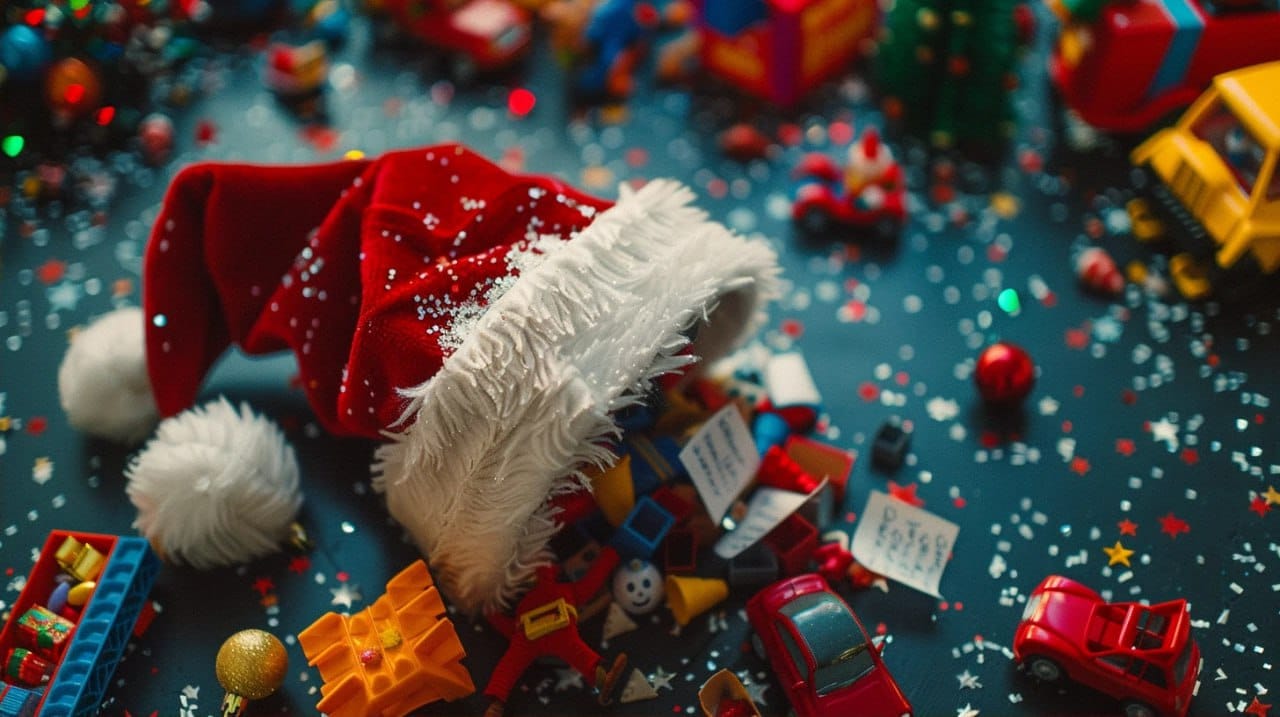How To Use Secret Santa to Teach Kids Financial Literacy
To understand the value of money, a child needs to learn how to spend it. Here’s when to start teaching financial literacy — and why Secret Santa is an ideal way to build those skills.

The game is easy to turn into a lesson if you set it up the right way. We’ll share how to run Secret Santa and explain the benefits.
When To Teach a Child To Handle Money
Financial literacy can seem complicated — something to postpone until school starts. In reality, handling money isn’t only about savings and deposits. It’s also about understanding where the resources come from to buy clothes, toys, sweets, and other everyday things.
We've studied the recommendations of psychologists and financial advisors, and here are the stages they highlight:
- Ages 2–3 — a toddler doesn’t yet understand what money is, but you can explain simple ideas using toys. Show how to trade toys to illustrate value.
- Ages 3–4 — a child begins to grasp that money exists and that it buys things. This is the time to explain that some items cost more and require more money. A simple role-play game like The Shop works perfectly.
- Ages 6–7 — once kids start school, they often receive a small allowance. It’s a great moment to let them experiment: manage money on their own, spend it, and save it.
- Ages 9–10 — at this stage, a child can set their first financial goals. Ask what they’re dreaming about and explain where the money for those wishes might come from.
Why A Game Works Better Than Talks Or Cartoons
There are many ways to explain what money is and how to handle it. Here’s why a game is the most effective format.
| Game | Cartoons | Conversations |
|---|---|---|
| The child is an active participant. | The child passively consumes information. | The child participates, but less actively than an adult. |
| Shows the results of decisions clearly. | Doesn’t build cause-and-effect links. | Conclusions stay abstract and theoretical. |
| Develops new skills. | Limited skill development. | Limited skill development. |
| Naturally keeps interest and motivation to continue. | Can be engaging only because scenes keep changing. | Requires extra effort to keep a child engaged. |
| Information sticks quickly and for a long time. | Information is quickly forgotten. | Information may stick, but is easier to forget. |
How To Organize a Secret Santa Game
Your kids can play with classmates, friends, or the whole family. Most often the exchange happens before Christmas, but you can also organize it before summer break, graduation, or any other occasion. The rules are simple: each player secretly prepares a gift for the person whose name they drew; on the set day, everyone receives surprises from their Secret Santa.
To make the mechanics crystal clear, here’s a step-by-step guide.
Step 1. Decide on the number of participants.
A child can play Secret Santa with parents, classmates, or friends from an after-school club. The key is to have more than three players.
Step 2. Do the drawing.
To assign Secret Santas, players write their names on pieces of paper and draw them from the hat. Older kids can use the MySanta service. It runs the drawing quickly, lets you build a wishlist, and supports exceptions.
Step 3. Agree on a gift budget.
Set spending limit for everyone and choose age-appropriate limits. This is the time to explain what gifts fit the budget and which ones don’t, and to help your child choose something that matches the limit.
You can’t give Lily an iPhone because it costs $700, and you only have $5. But you can choose a sweets set, a lip balm set, or a fun keychain because those cost less.
Step 4. Choose the gift exchange day.
Talk with the other participants and pick a realistic timeline for buying gifts. Explain that important purchases need planning.
We agreed to exchange gifts on December 24. That means we have two weeks to decide what to give Lily and where to buy the gift.
Step 5. Buy the gift.
Together, pick a few options and let your child make the final decision. If money is left over, consider a small extra surprise.
Look, this keychain toy cost you only $4, so you have $1 left. What else could you buy with that?
Step 6. Exchange gifts on the chosen day.
Now for the best part — making your recipient happy and receiving a Secret Santa gift in return.
Secret Santa & Financial Literacy: How It Works
Secret Santa teaches kids to give and to pay attention to the people around them. It also helps them make purchase decisions, plan a budget, and learn to save. Here’s how.
Budget Planning
In Secret Santa, the budget is usually limited – say, $5 or $10. A child has to decide how to use that money: buy one bigger present and spend it all, or put together a few smaller surprises.
If you want to buy Alice this doll, you won’t have money left for a notebook. You could gift the notebook and add a couple of small items. Think about how you want to spend the money.
Comparing Prices
The game makes it easy to show that prices can vary a lot — not only because of size or usefulness, but also by store.
In the store we've just been to, this plush toy was $9. Here, it's $10.50. Where do you think it makes more sense to buy it?
Decision-Making
Parents help with the choice, but thanks to the game kids practice deciding for themselves how to spend money. They look through options and think about which one the recipient will enjoy most. That way they don’t just spend — they make a considered purchase.
We picked six great gifts Kevin would love. Tomorrow you can buy the one you want to give him.
Understanding That Money Is Limited
In this game the child makes real purchases and learns that money is a limited resource — it can run out. A set amount won’t buy everything you want – it buys what fits the budget.
Learning To Save
Secret Santa doesn’t directly involve saving, but you can add it if your child wants to buy something pricier. Suggest setting aside pocket money or "earning" the difference by helping with household tasks. That way kids learn to set financial goals and find ways to reach them.
The action figure costs $15, and you only have $10. If you really want to give Manuel this gift, you can save up — set aside pocket money or earn it by doing the dishes.
What a Child Can Give In Secret Santa
Choosing the right present can be hard. Here are a few simple ideas — for other children, for parents, and for a teacher.
for other kids
Sweets Set
Gummies, candy-coated chocolates, and chocolate truffles are universal favorites. This is a strong choice when the budget is tight or you don’t know the recipient well. Pick a ready-made set or build your own — add better-for-you treats or arrange them like a bouquet.
Puzzles
A good option for any age. Choose large, simple animal puzzles for toddlers and more complex sets featuring favorite characters for older kids.
Drawing Kit
Almost all children love to draw, so this won’t sit on a shelf. It doesn’t have to be markers or colored pencils — try finger paints, chalk, or glow-in-the-dark pens. Choose something your own child would enjoy; chances are the recipient will be thrilled too.
for mom and dad
Mug
Useful and memorable. Pick a mug with a sweet message — it will lift the mood every time Mom or Dad has tea.
Photo Album
A lovely way to keep treasured memories. Print photos and add drawings, stickers, and little cut-outs. The child will enjoy crafting it, and a parent will be touched to receive something so personal.
Greeting Card
The simplest gift is often the most heartfelt. Encourage your child to write kind wishes and warm words any parent would love to read. A handmade card will be even more special in a few years.
for a teacher
Tea
Tea works for almost everyone, teachers included. If you don’t know their preferences, look at sampler sets. They let the recipient taste different varieties and find a favorite.
Notebook
A practical gift every teacher can use. Consider dated formats or designs with ribbon markers. To make it personal, have your child write a short message inside — that thoughtful touch will melt any teacher’s heart.
Desk Calendar
A stylish addition to a workspace. A desk calendar makes planning easier and keeps important dates in view. Let your child pick the design — cheerful pups for a smile, or soft florals for a cozy feel.
4 Games That Help Build Money Skills
If you’ve already played Secret Santa and want new, useful activities, try these — from simple role-plays for little ones to great board games for grade-schoolers.
The Shop
Everyone knows how to play the shop. It requires no extra spending: choose goods, find money, and explain the rules. It’s perfect for the youngest children and shows how purchases work. For extra fun, set up a real counter and switch roles with your child.
Mini-Bank
Invite your child to run a mini-bank. They can collect spare change from family members and be responsible for keeping it safe. The key rule is to agree on a shared goal: movie tickets for the family, a pizza night, or a new board game. This teaches saving and planning purchases.
Family Budget
In this board game, every participant has a role: a parent earns income, a daughter gets pocket money, and so on. The winner is whoever manages money well and meets their goal. With bright cards and lots of fun mechanics, it’s an excellent choice for family game night.
Monopoly
The classic money game. It explains investing and helps build strategic thinking. If the standard version feels boring, try a themed edition. For example, a Monopoly Harry Potter Edition can keep kids engaged.
Conclusion
Explaining what money is and how to use it is easy when you do it through play. Start with simple, hands-on examples, like Secret Santa, and your child will stay interested.

FAQs
What’s the right Secret Santa budget for kids?
For preschoolers and elementary students, $5 is a reasonable range. For tweens and teens, $10 to $15 works well. Explain that everyone should buy gifts within the given amount, and share gift examples within this amount to make choosing easier.
How can I use Secret Santa to teach price comparison?
Have your child check two stores or sites for the same item and note the difference. Talk about shipping, return policies, and ratings, not just price. Let them choose where to buy and explain why.
How do I include saving in everyday life after the game?
Give your kid three jars: for spending, saving, and giving. Let the child distribute the allowance between the jars under your supervision. To encourage saving, link them to small goals or something your kid wants to buy so the progress feels tangible.


